Secretary of State for Defence
The secretary of state for defence (defence secretary) is a secretary of state in the Government of the United Kingdom, with responsibility for the Ministry of Defence.[3] As a senior minister, the incumbent is a member of the Cabinet of the United Kingdom.
| Secretary of State for Defence | |
|---|---|
_(2022).svg.png.webp) | |
 | |
| Ministry of Defence | |
| Style |
|
| Type | Minister of the Crown |
| Status | Secretary of state |
| Abbreviation | SoSDef |
| Member of | |
| Reports to | The Prime Minister |
| Seat | Westminster |
| Nominator | The Prime Minister |
| Appointer | The Crown on advice of the Prime Minister |
| Term length | At His Majesty's pleasure |
| Constituting instrument | Defence (Transfer of Functions) Act 1964 section 1(1)(a) |
| Precursor | Minister of Defence |
| Formation | 1 April 1964 |
| First holder | Peter Thorneycroft |
| Unofficial names | Defence Secretary |
| Deputy | Minister for Defence Procurement (since 2020) Minister of State for the Armed Forces (before 2020) |
| Salary | £154,089 per annum (2022)[1] (including £86,584 MP salary)[2] |
| Website | www |
| This article is part of a series on |
| Politics of the United Kingdom |
|---|
_(2022).svg.png.webp) |
|
The post of secretary of state for defence was created on 1 April 1964, replacing the positions of Minister of Defence, First Lord of the Admiralty, Secretary of State for War, and Secretary of State for Air, while the individual offices of the British Armed Forces were abolished and their functions transferred to the Ministry of Defence. In 1997, Michael Portillo was filling this post at the time of the Portillo moment.[4] In 2019, Penny Mordaunt became the UK's first female defence secretary.[5]
The secretary of state is supported by the other ministers in the Defence Ministerial Team and the MOD permanent secretary. The corresponding shadow minister is the shadow secretary of state for defence, and the secretary of state is also scrutinised by the Defence Select Committee.[6]
The current secretary of state for defence is Grant Shapps who was appointed on 31st August 2023 by Prime Minister Rishi Sunak after the resignation of Ben Wallace.
Responsibilities
In contrast to what is generally known as a defence minister in many other countries, the Defence Secretary's remit includes:
- Strategic military and defensive operations. The postholder is a member of the National Security Council, and chair of the Defence Council, to which the monarch has given the power to command the Armed Forces.
- Oversight of Defence Intelligence
- Relations with international partnerships, including NATO
- Defence policy (Trident nuclear weapons programme), resourcing and planning
- Communications on defence[7]
History
Minister for Co-ordination of Defence (1936–1940)
The position of Minister for Co-ordination of Defence was a British Cabinet-level position established in 1936 to oversee and co-ordinate the rearmament of Britain's defences. It was established by the Prime Minister, Stanley Baldwin in response to criticism that Britain's armed forces were understrength compared to those of Nazi Germany. When the Second World War broke out, the new Prime Minister Neville Chamberlain formed a small War Cabinet and it was expected that the Minister would serve as a spokesperson for the three service ministers, the Secretary of State for War, the First Lord of the Admiralty and the Secretary of State for Air; however, political considerations resulted in all three posts being included in the Cabinet, and this role proved increasingly redundant. In April 1940 the position was formally wound up and the functions transferred to other Ministers.
Minister of Defence (1940–1964)
The post of Minister of Defence was responsible for co-ordination of defence and security from its creation in 1940 until its abolition in 1964. The post was a Cabinet level post and generally ranked above the three service ministers, some of whom, however, continued to also serve in Cabinet.
On his appointment as Prime Minister in May 1940, Winston Churchill created for himself the new post of Minister of Defence. The post was created in response to previous criticism that there had been no clear single minister in charge of the prosecution of World War II. In 1946, the post became the only cabinet-level post representing the military, with the three service ministers – the Secretary of State for War, the First Lord of the Admiralty, and the Secretary of State for Air, now formally subordinated to the Minister of Defence.
Secretary of State for Defence (1964–present)
The post was created in 1964 as successor to the posts of Minister for Coordination of Defence and Minister of Defence. It replaced the positions of First Lord of the Admiralty, Secretary of State for War and Secretary of State for Air, as the Admiralty, War Office and Air Ministry were merged into the Ministry of Defence (the Secretary of State for War had already ceased to be a cabinet position in 1946, with the creation of the cabinet-level Minister of Defence).
| Royal Navy | British Army | Royal Air Force | Co-ordination | |
| 1628 | First Lord of the Admiralty (1628–1964) |
|||
| 1794 | Secretary of State for War (1794–1801) |
|||
| 1801 | Secretary of State for War and the Colonies (1801–1854) |
|||
| 1854 | Secretary of State for War (1854–1964) |
|||
| 1919 | Secretary of State for Air (1919–1964) |
|||
| 1936 | Minister for Co-ordination of Defence (1936–1940) | |||
| 1940 | Minister of Defence (1940–1964) | |||
| 1964 | Secretary of State for Defence (1964–present) | |||
Secretaries of State for Defence (1964–present)
| Portrait | Name (birth–death) |
Term of office | Length of term | Party | Ministry | ||
|---|---|---|---|---|---|---|---|
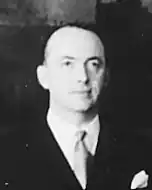 |
Peter Thorneycroft MP for Monmouth (1909–1994)[8] |
1 April 1964 | 16 October 1964 | 6 months and 15 days (was Minister of Defence immediately before) |
Conservative | Douglas-Home | |
 |
Denis Healey MP for Leeds East (1917–2015)[9] |
16 October 1964 | 19 June 1970 | 5 years, 8 months and 3 days | Labour | Wilson (I & II) | |
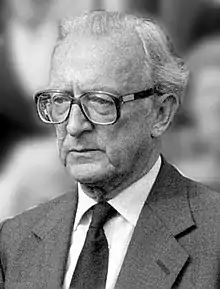 |
Peter Carrington 6th Baron Carrington (1919–2018) |
20 June 1970 | 8 January 1974 | 3 years, 6 months and 19 days | Conservative | Heath | |
| Ian Gilmour MP for Central Norfolk (1926–2007)[10] |
8 January 1974 | 4 March 1974 | 1 month and 24 days | Conservative | |||
| Roy Mason MP for Barnsley (1924–2015)[11] |
5 March 1974 | 9 September 1976 | 2 years, 6 months and 4 days | Labour | Wilson (III & IV) | ||
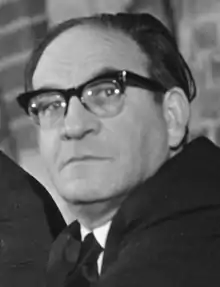 |
Fred Mulley MP for Sheffield Park (1918–1995)[12] |
10 September 1976 | 4 May 1979 | 2 years, 7 months and 24 days | Labour | Callaghan | |
.jpg.webp) |
Francis Pym MP for Cambridgeshire (1922–2008)[13] |
5 May 1979 | 4 January 1981 | 1 year, 7 months and 30 days | Conservative | Thatcher I | |
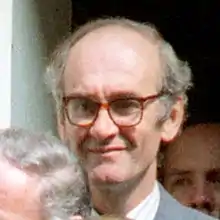 |
John Nott MP for St Ives (born 1932)[14] |
5 January 1981 | 5 January 1983 | 2 years | Conservative | ||
.jpg.webp) |
Michael Heseltine MP for Henley (born 1933)[15] |
6 January 1983 | 8 January 1986 | 3 years and 2 days | Conservative | Thatcher II | |
 |
George Younger MP for Ayr (1931–2003)[16][17] |
9 January 1986 | 23 July 1989 | 3 years, 6 months and 14 days | Conservative | ||
| Thatcher III | |||||||
 |
Tom King MP for Bridgwater (born 1933)[18] |
28 July 1989 | 9 April 1992 | 2 years, 8 months and 12 days | Conservative | ||
| Major I | |||||||
.jpg.webp) |
Malcolm Rifkind MP for Edinburgh Pentlands (born 1946)[19] |
10 April 1992 | 4 July 1995 | 3 years, 2 months and 24 days | Conservative | Major II | |
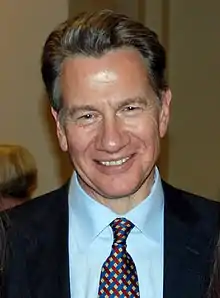 |
Michael Portillo MP for Enfield Southgate (born 1953)[20] |
5 July 1995 | 2 May 1997 | 1 year, 9 months and 27 days | Conservative | ||
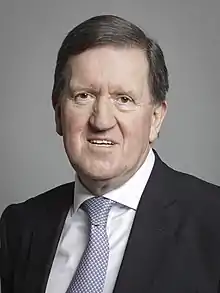 |
George Robertson MP for Hamilton South (born 1946)[21] |
3 May 1997 | 11 October 1999 | 2 years, 5 months and 8 days | Labour | Blair I | |
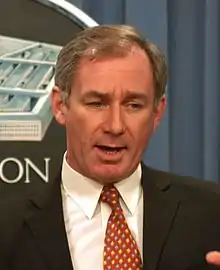 |
Geoff Hoon MP for Ashfield (born 1953)[22] |
11 October 1999 | 6 May 2005 | 5 years, 6 months and 25 days | Labour | ||
| Blair II | |||||||
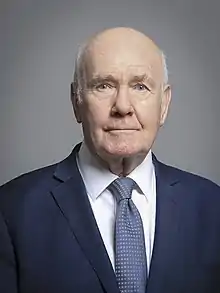 |
John Reid MP for Airdrie and Shotts (born 1947)[23] |
6 May 2005 | 5 May 2006 | 11 months and 29 days | Labour | Blair III | |
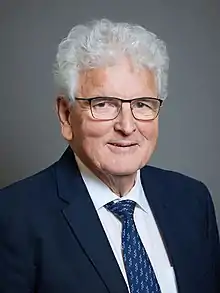 |
Des Browne MP for Kilmarnock and Loudoun (born 1952)[24] |
5 May 2006 | 3 October 2008 | 2 years, 4 months and 28 days | Labour | ||
| Brown | |||||||
 |
John Hutton MP for Barrow and Furness (born 1955)[25] |
3 October 2008 | 5 June 2009 | 8 months and 2 days | Labour | ||
.jpg.webp) |
Bob Ainsworth MP for Coventry North East (born 1952)[26] |
5 June 2009 | 11 May 2010 | 11 months and 6 days | Labour | ||
 |
Liam Fox MP for North Somerset (born 1961)[27][28] |
12 May 2010 | 14 October 2011 | 1 year, 5 months and 3 days | Conservative | Cameron–Clegg (Con.–L.D.) | |
 |
Philip Hammond MP for Runnymede and Weybridge (born 1955)[29][30] |
14 October 2011 | 15 July 2014 | 2 years, 9 months and 1 day | Conservative | ||
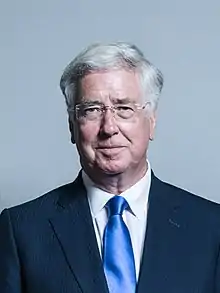 |
Michael Fallon MP for Sevenoaks (born 1952)[31][32] |
15 July 2014 | 1 November 2017 | 3 years, 3 months and 17 days | Conservative | ||
| Cameron II | |||||||
| May I | |||||||
| May II | |||||||
 |
Gavin Williamson MP for South Staffordshire (born 1976)[33][34] |
2 November 2017 | 1 May 2019 | 1 year, 5 months and 29 days | Conservative | ||
 |
Penny Mordaunt MP for Portsmouth North (born 1973)[35][36] |
1 May 2019 | 24 July 2019 | 2 months and 23 days | Conservative | ||
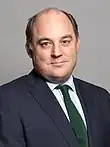 |
Ben Wallace MP for Wyre and Preston North (born 1970)[37][38] |
24 July 2019 | 31 August 2023 | 4 years, 1 month and 7 days | Conservative | Johnson I | |
| Johnson II | |||||||
| Truss | |||||||
| Sunak | |||||||
 |
Grant Shapps MP for Welwyn Hatfield (born 1968)[39] |
31 August 2023 | Incumbent | 1 month and 25 days* | Conservative | ||
* Incumbent's length of term last updated: 25 October 2023.
References
- "Salaries of Members of His Majesty's Government – Financial Year 2022–23" (PDF). 15 December 2022.
- "Pay and expenses for MPs". parliament.uk. Retrieved 15 December 2022.
- "Secretary of State for Defence". gov.uk. Retrieved 30 June 2021.
- "BBC Rewind: Michael Portillo loses Enfield Southgate". BBC News. 17 November 2014. Retrieved 9 May 2021.
One of the most high-profile victims of the Labour party landslide in the 1997 general election was John Major's Defence Secretary, Michael Portillo.
- "Penny Mordaunt - the UK's first female defence secretary". BBC News. 2 May 2019. Retrieved 10 June 2021.
Penny Mordaunt has become the UK's first female defence secretary after Gavin Williamson was sacked.
- "Secretary of State for Defence, Ben Wallace, faces questioning from Defence Committee". parliament.uk. 18 June 2021. Retrieved 29 December 2021.
- "Secretary of State for Defence - GOV.UK". www.gov.uk.
- "Mr Peter Thorneycroft". Parliamentary Debates (Hansard). Retrieved 2 November 2017.
- "Lord Healey". UK Parliament. Retrieved 2 November 2017.
- "Lord Gilmour of Craigmillar". UK Parliament. Retrieved 2 November 2017.
- "Lord Mason of Barnsley". UK Parliament. Retrieved 2 November 2017.
- "Lord Mulley". UK Parliament. Retrieved 2 November 2017.
- "Lord Pym". UK Parliament. Retrieved 2 November 2017.
- "Rt Hon Sir John Nott". UK Parliament. Retrieved 2 November 2017.
- "Lord Heseltine". UK Parliament. Retrieved 25 July 2021.
- "Rt Hon Sir George Younger". UK Parliament. Retrieved 2 November 2017.
- George Jones (27 January 2003). "Thatcher's ally George Younger dies at 71". The Telegraph. Archived from the original on 12 January 2022. Retrieved 3 November 2017.
- "Lord King of Bridgwater". UK Parliament. Retrieved 25 July 2021.
- "Rt Hon Sir Malcolm Rifkind QC". UK Parliament. Retrieved 2 November 2017.
- "Rt Hon Michael Portillo". UK Parliament. Retrieved 2 November 2017.
- "Lord Robertson of Port Ellen". UK Parliament. Retrieved 25 July 2021.
- "Mr Geoffrey Hoon". UK Parliament. Retrieved 2 November 2017.
- "Lord Reid of Cardowan". UK Parliament. Retrieved 25 July 2021.
- "Lord Browne of Ladyton". UK Parliament. Retrieved 25 July 2021.
- "Lord Hutton of Furness". UK Parliament. Retrieved 25 July 2021.
- "Rt Hon Bob Ainsworth". UK Parliament. Retrieved 25 July 2021.
- "Rt Hon Dr Liam Fox MP". UK Parliament. Retrieved 25 July 2021.
- "Who's who in the coalition cabinet". The Guardian. 13 May 2010. Retrieved 3 November 2017.
- "Rt Hon Philip Hammond MP". UK Parliament. Retrieved 25 July 2021.
- "Liam Fox quits as defence secretary". BBC News. 14 October 2011. Retrieved 3 November 2017.
- "Rt Hon Sir Michael Fallon MP". UK Parliament. Retrieved 2 November 2017.
- "Reshuffle at-a-glance: In, out and moved about". BBC News. 15 July 2014. Retrieved 3 November 2017.
- "Rt Hon Gavin Williamson MP". UK Parliament. Retrieved 2 November 2017.
- "Gavin Williamson replaces Michael Fallon as defence secretary". BBC News. 2 November 2017. Retrieved 2 November 2017.
- "Rt Hon Penny Mordaunt MP". UK Parliament. Retrieved 25 July 2021.
- "Gavin Williamson sacked over Huawei leak". 1 May 2019. Retrieved 2 May 2019.
- "Rt Hon Ben Wallace MP". UK Parliament. Retrieved 25 July 2021.
- "Ben Wallace Named New Defence Secretary". Forces Network. 24 July 2019. Retrieved 24 July 2019.
- "Grant Shapps". UK Parliament. Retrieved 2 September 2023.
.jpg.webp)